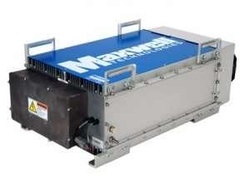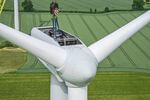03/29/2011
Windfair.net - Special Online Editorial - Ultracapacitor Technology
ULTRACAPACITOR SYSTEMS AND MORE
What are Ultracapacitor Systems?
By physically separating positive and negative charges, an Ultracapacitor system (UCs) stores electricity in a different manner to batteries that do so chemically. The electrical charge produced can be compared with the static electricity build up on a balloon. However, the charge is much larger, due to the extremely dense interior material surface contact area of UCs
An advantage of the UCs is its super fast rate of charging and discharging, which is solely determined by its physical properties. A battery relies on a slower chemical reaction for energy.
A disadvantage of UCs to date was that they could store less energy than that of a battery. However, now UCs have become very efficient at capturing the energy (electricity) generated from regenerative braking and providing energy for acceleration. With no moving parts, these modules are also extremely durable – in excess of 500,000 plus charge / recharge cycles.
An Ultracapacitor system is in essence a double-layer capacitor that polarizes an electrolytic solution to store energy electrostatically. Chemical reactions play no role in the storage of energy, even though it is an electrochemical device. The mechanism is highly reversible, and allows it to charge and discharge itself >100.000 of times.
Once the UCs is charged and energy stored, a load (e.g. an electric vehicle's motor) can use this energy. The amount of energy stored is very large compared to a standard capacitor because of the enormous surface area created by the porous carbon electrodes and the small charge separation created by the dielectric separator.
Ultracapacitor module systems on the market today:
On the market today, a 56-volt Ultracapacitor module has been specifically developed to address the short-term ride-through and bridge power requirements of uninterruptible power supply (UPS) systems for mission-critical installations such as data centers, hospitals, factories and telecommunication facilities.
In collaboration with UPS system integrators, a US-based company, Maxwell Technologies developed the system to reduce the effects of short power interruptions on digital systems and sensitive medical and manufacturing equipment. A further development is the ability to provide bridge power to a generator or other long-term backup power source should total power outage take place. UCs are currently being used for wind, solar and hydro energy storage.
Benefits:
The benefits of the Maxwell 56-volt Ultracapacitor module are that it: (1) has maintenance-free operation; (2) a minimum of 14-year life span, ensuring low cost of ownership and a fast Return On Investment; (3 ) is available in 4, 5, 6.5, and 10-kW versions to easily configure for UPS system requirements (4) can be connected in series to cater for systems requiring up to 750 Voltage (5) its rugged construction meets IBC Zone 4 earthquake resistance standard requirements; and (6) is environmentally friendly because heavy metals or toxic substances require special no recycling.
A technology for Japan and the entire industry?
Ultracapacitor system modules - as offered on the market today provide a very unique future technology for the wind industry.
Apropos, what about the current energy crises in Japan? Might this not be a technology that could make a difference in this catastrophe devastated country?
Maybe Ultracapacitor system technology can assist the Japanese in optimizing one of the only mildly-affected sources of energy in Japan, after the devastating earthquake, tsunami and Fukushima “Super Gau” – the wind energy sector.
Interested entrepreneurs, NGOs, public and private sector development aid institutions and companies, should most definitely look at this technology.
Please contact Trevor Sievert at ts@windfair.net or Errol Stryker at es@windfair.us to pass on Maxwell’s contact details.
The Windfair.net community sends its deepest condolences to the families of those who have perished and missing family members
www.windfair.net is the largest international B2B Internet platform – ultimately designed for connecting wind energy enthusiasts and companies across the globe!
What are Ultracapacitor Systems?
By physically separating positive and negative charges, an Ultracapacitor system (UCs) stores electricity in a different manner to batteries that do so chemically. The electrical charge produced can be compared with the static electricity build up on a balloon. However, the charge is much larger, due to the extremely dense interior material surface contact area of UCs
An advantage of the UCs is its super fast rate of charging and discharging, which is solely determined by its physical properties. A battery relies on a slower chemical reaction for energy.
A disadvantage of UCs to date was that they could store less energy than that of a battery. However, now UCs have become very efficient at capturing the energy (electricity) generated from regenerative braking and providing energy for acceleration. With no moving parts, these modules are also extremely durable – in excess of 500,000 plus charge / recharge cycles.
An Ultracapacitor system is in essence a double-layer capacitor that polarizes an electrolytic solution to store energy electrostatically. Chemical reactions play no role in the storage of energy, even though it is an electrochemical device. The mechanism is highly reversible, and allows it to charge and discharge itself >100.000 of times.
Once the UCs is charged and energy stored, a load (e.g. an electric vehicle's motor) can use this energy. The amount of energy stored is very large compared to a standard capacitor because of the enormous surface area created by the porous carbon electrodes and the small charge separation created by the dielectric separator.
Ultracapacitor module systems on the market today:
On the market today, a 56-volt Ultracapacitor module has been specifically developed to address the short-term ride-through and bridge power requirements of uninterruptible power supply (UPS) systems for mission-critical installations such as data centers, hospitals, factories and telecommunication facilities.
In collaboration with UPS system integrators, a US-based company, Maxwell Technologies developed the system to reduce the effects of short power interruptions on digital systems and sensitive medical and manufacturing equipment. A further development is the ability to provide bridge power to a generator or other long-term backup power source should total power outage take place. UCs are currently being used for wind, solar and hydro energy storage.
Benefits:
The benefits of the Maxwell 56-volt Ultracapacitor module are that it: (1) has maintenance-free operation; (2) a minimum of 14-year life span, ensuring low cost of ownership and a fast Return On Investment; (3 ) is available in 4, 5, 6.5, and 10-kW versions to easily configure for UPS system requirements (4) can be connected in series to cater for systems requiring up to 750 Voltage (5) its rugged construction meets IBC Zone 4 earthquake resistance standard requirements; and (6) is environmentally friendly because heavy metals or toxic substances require special no recycling.
A technology for Japan and the entire industry?
Ultracapacitor system modules - as offered on the market today provide a very unique future technology for the wind industry.
Apropos, what about the current energy crises in Japan? Might this not be a technology that could make a difference in this catastrophe devastated country?
Maybe Ultracapacitor system technology can assist the Japanese in optimizing one of the only mildly-affected sources of energy in Japan, after the devastating earthquake, tsunami and Fukushima “Super Gau” – the wind energy sector.
Interested entrepreneurs, NGOs, public and private sector development aid institutions and companies, should most definitely look at this technology.
Please contact Trevor Sievert at ts@windfair.net or Errol Stryker at es@windfair.us to pass on Maxwell’s contact details.
The Windfair.net community sends its deepest condolences to the families of those who have perished and missing family members
www.windfair.net is the largest international B2B Internet platform – ultimately designed for connecting wind energy enthusiasts and companies across the globe!
- Source:
- Maxwell
- Author:
- Posted by Trevor Sievert, Online Editorial Journalist
- Email:
- ts@windfair.net & es@windfair.net
- Link:
- www.windfair.net & www.windfair.us/...
- Keywords:
- wind energy, wind power, wind turbine, onshore, offshore, windmill, www.windfair.net, Trevor Sievert, ECA



























